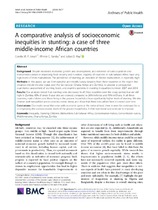| dc.contributor.author | Jonah, Coretta M. P. | |
| dc.contributor.author | Sambu, Winnie C. | |
| dc.contributor.author | May, Julian D. | |
| dc.date.accessioned | 2021-07-13T10:18:28Z | |
| dc.date.available | 2021-07-13T10:18:28Z | |
| dc.date.issued | 2018 | |
| dc.identifier.citation | Jonah, C. M. P. et al. (2018). A comparative analysis of socioeconomic inequities in stunting: A case of three middle-income African countries. Archives of Public Health, 76(1), 1–15. https://doi.org/10.1186/s13690-018-0320-2 | en_US |
| dc.identifier.issn | 0778-7367 | |
| dc.identifier.uri | https://doi.org/10.1186/s13690-018-0320-2 | |
| dc.identifier.uri | http://hdl.handle.net/10566/6395 | |
| dc.description.abstract | : Despite increased economic growth and development, and existence of various policies and
interventions aimed at improving food security and nutrition, majority of countries in sub-Saharan Africa have very
high levels of child malnutrition. The prevalence of stunting, an indicator of chronic malnutrition, is especially high. In this paper, we use Demographic and Health Survey datasets from three countries in the region that
obtained middle-income status over the last decade (Ghana, Kenya and Zambia), to provide a comparative
quantitative assessment of stunting levels, and examine patterns in stunting inequalities between 2007 and 2014. | en_US |
| dc.language.iso | en | en_US |
| dc.publisher | BCM | en_US |
| dc.subject | Inequality | en_US |
| dc.subject | Stunting | en_US |
| dc.subject | Children | en_US |
| dc.subject | Malnutrition | en_US |
| dc.subject | Sub-Saharan Africa | en_US |
| dc.subject | Concentration indices | en_US |
| dc.title | A comparative analysis of socioeconomic inequities in stunting: A case of three middle-income African countries | en_US |
| dc.type | Article | en_US |

